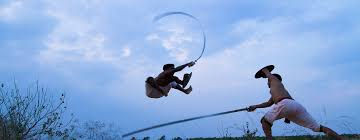African Martial Arts: Donga
- Amir Hamza
- Jul 6, 2020
- 3 min read
Moving further south, we have the country of South Africa and its legendary style of stick fighting which we are all familiar with from the Black Panther films. Featured as a major part of the films plot and fight scene we see some authentic usage of African martial arts with cultural research and advice from martial artist Marrese Crump and South African veteran actor John Kani. We introduce to you: Donga.

Martial Art: Donga/Dlala 'Nduku
Style: Weaponry
Country: South Africa
Origin: 1600s Umhlatuze Valley (various groups in Southern Africa)
History: The martial art is sometimes referred to as Nguni/Zulu Stick fighting. The style is practiced by many Bantu ethnicities such as the Zulu, Swazi and Ndebele in the southern Nguni and Bomvana, Mpondo, Thembu and Xhosa in the Northern Nguni. The Origin of the style is believed to have started in the mid 1600s created by Gumede's son Amalandela or by Shaka Zulu, in the late 1700s to early 1800s. The style is originally restricted to males only and was originally a killing art used for warfare against other tribes.

Culture: Boys as young as 4 start their training with their first stick. Over the years, the practice of the art was for ritual purposes such as two men determining who is the Inkunzi (strongest or Bull), to settle disputes or disagreements, or to win over a bride. Amasoka (young warrior men) will compete at umemulo (womans coming out ceremony) to gain their attention. In more modern times it gets used for wedding ceremonies where the groom and brides household "get to know one another". During Apartheid South Africa, the practice was in decline to discourage South Africans from being able to rebel as well diminish traditional culture and used the styles warfare background as propaganda to further paint a violent negative image of the South African people groups living there at the times. Before the fight begins two fighters face each other and tap one another's shield or sticks. This is viewed as fair sportsmanship. In other instances, this rule is not followed as the fight can begin by landing descending strikes. These strikes may leave permanent scars called Inkamb' Beyibuza (wherever you go people ask what's that from) which are treated as a badge of honour. It is known that a stabbing strike was a common move used in warfare with an Assegai or Iklwa with the intent to kill. In modern bouts such weapons are not used in favour of non-lethal sticks, however the stabbing strike is seen as a disrespectful attack in some cases. Points are awarded per successful strike with different amounts depending on the body part. If the athletes are wearing body armour (in the case of a modern event), head shots can be worth 6 points (most valuable target). In some cases Headshots are prohibited for the sake of safety. The bouts are controlled by Referees (Igoso, Induna Yenzinsizwa) or war captains (Umphathi Wezinsizwa). The match ends when one of the competitors are knocked into unconsciousness or decide to yield from the fight or the time runs out. In the latter case, the victor is decided based on the points scored by each fighter.
Warrior: Northern Stick fighters use two sticks Isiquili/Induku a short stick for offense and Uboko for defense. Southern Stick Fighters use an Isiquili and an Izolihawu or knuckle shield for defense. Induku are a strong stick or shaft wood without a knob and generally around 88 cm (but can vary for the individual). Ubhoko (another name for the defensive sticks) are long smooth sticks that tapers down to a sharp point. Generally these are around 165 cm long. While it can be used as a stabbing weapon, protocol demands it be used defensively. Umsila is usually held on the defensive hand with the Ubhoko. Izolihawu (ihawu for short) is a small cow skinned oval shaped shield usually around 55-63 cm long and 31-33 cm wide.
Media/Potential: Donga is one of Africa's best known martial arts despite it being generically named as Zulu or Nguni stick fighting. It is known to have been practiced by Shaka Zulu and Nelson Mandela. The style was also featured in shows like the BBC's Last Man Standing and Morning Star's TV series Deadliest Warriors. This style was infamously featured as the main style in the Black Panther films during the ritual combat at the waterfall. Marrese Crump (as mentioned before) had made sure to study the style and teach it to the cast and stunt crew. Chadwick Boseman, Michael B.Jordan and Winston Duke showcase their new found knowledge of the style for the films ritual combat scenes between T'Challa and M'Baku then later N'Jadaka/Erik.



Comments